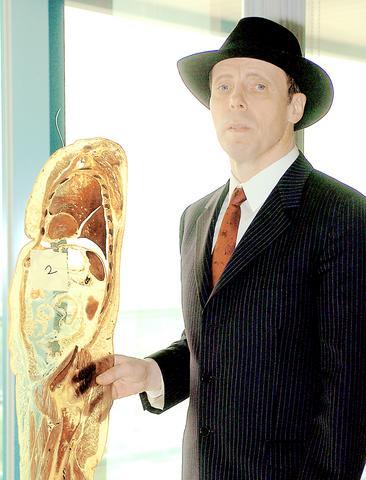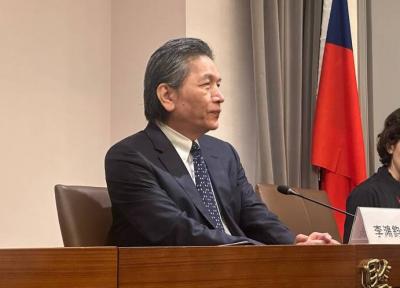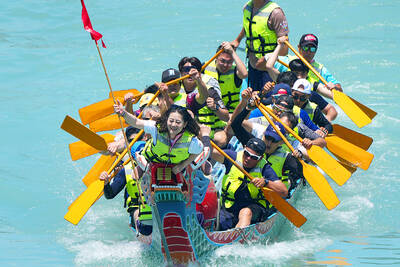Taipei Times: It is interesting that controversy has almost become an intrinsic part of the exhibit. What do you think?
Gunther Von Hagens: I think it's great, because it is very important for people to discuss and to mentally see the exhibition from different angles. I would even go so far as to say that the real success of Body Worlds is not in how many people come -- although [so many] have come, certainly [many more] have discussed it.

PHOTO: LU CHUN-WEI, TAIPEI TIMES
TT: Do you see yourself as doing away with stigmas regarding dead bodies?
Von Hagens: I see myself as re-democratizing. Because for 300 years in Europe, this was normal in so-called anatomical theaters. If you had some money, you could go, as normal people, to watch an autopsy. When you go to Italy, there are still these specimens, real specimens, of this kind, in lifelike positions. But this is all forgotten now, and when [people] are not used to a body, suddenly it is taboo, you know? So I worked out at the time why so many people came [to the exhibit] -- because there is a vacuum, a thirst for knowledge of the authentic body, a thirst of knowledge in a time when lay people are professionalized by the media as never before.
Like you, you write in the newspaper about the knee-joint injury of a football player, the heart attack of a politician. But people have never seen something like that ... There is a vacuum of knowledge, especially in the media. There is so much that is indirect that there is now a search for the original. The thirst to see the original is greater than ever before.
TT: What is the significance of seeing a real human body?
Von Hagens: I can tell you a wonderful example. What is the difference between going to a museum to see the work of Van Gogh and Rembrandt and seeing a copy? I think it's a unique human feature, it is human nature that we are more satisfied when it is real. The tension of looking can never be relieved by just a copy. We never question how important our thirst of knowledge for the "original" is in other parts of the museum. But for death -- we've started a kind of denial of death already.
TT: But even a Van Gogh is not an original in the sense that an artist recreates a scene. So, are you an artist?
Von Hagens: Here, more importantly, the material is original. I know from 15 years as a lecturer of anatomy at Heidelberg University that remembrance of the cadaver is much stronger than of anywhere else. Why don't students just learn from books? I don't want to be operated on by someone who learns from books -- it's so different.
TT: But with plastination, you shape bodies into certain poses. Do you see yourself as an artist then? Or a scientist?
Von Hagens: I'm certainly not an artist. I think I am a skillful anatomist. I'm an inventor-anatomist. I combine education and entertainment -- edu-tainment. I think everybody in anatomy always shapes the body -- the way I open it. I open it from here in the back, I cut it in pieces. When I decide what I dissect, it is already a kind of mental process. I decide what to show. Should I put it in an awkward way that looks terrible, or should I put it in a pleasing way?
Posing the body
TT: How do you decide how to put the people into poses?
Von Hagens: I coined a word for this, it is "anatomy art" -- the aesthetic, instructive presentation of the body material. The dead body is of no use for our living except for mourning. When it is used for our living, it is only because we can learn from it, can transfer knowledge from the dead body to the living body -- but how can I do this? I can do this more by showing the body to the living, in the same posture, in a living posture. Now, because of the invention of plastination, it is possible to fragment the body, open body doors. And [though this] doesn't fit into our conventional knowledge of what it looks like, it's a necessary outcome of this instructional approach that you look at it as an artistic end.
TT: So it is a creative process.
Von Hagens: Yes, why not? As an inventor I have to be creative. Each pose has its anatomical potential. Teaching potential. And each anatomical teaching correlates best with a pose. When I look at a body, I have a thirst for a presentation of the body that has never been seen by Man's eyes before, that is striking for the understanding of the body, the beauty.
TT: So what is the plastinated specimen itself? Aren't 70 percent of bodily fluids replaced with polymers that you inject?
Von Hagens: This is a big question, which the courts are now debating.
TT: What do you think?
Von Hagens: The human body plastinate is a new presentation of the human body -- it's a new form, a new shape, a new representative of the human body. It is a structural framework of the real human body imbued with plastic.
TT: So it is not a human body?
Von Hagens: It is an alloy -- it is not the real and it is not the not real -- it is something in between. For example, we have many presentations of the body -- one is the skeleton. Is the skeleton the human body or not? Is a mummy a human body or not? It's certainly different when the body has died. We have different kinds of bodies: we have the mourning body for mourning, we have the teaching body, and with plastination, a new body enters our society. The whole body plastinates are a new body entity that has become part of our culture.
Selling the body
TT: Are these specimens for sale?
Von Hagens: Yes, but only to educational research institutes.
TT: How much do they sell for?
Von Hagens: It depends on what my current interest is; how it fits into my program. A whole body is 40,000 euros to 50,000 euros (US$47,500 to US$59,300). It's about 40 euros for lower-arm slices and a mid-section is, depending on the quality and the sex, about 5,000 euros.
TT: Which sex costs more?
Von Hagens: Women. Women cost more because about 30 percent have no uterus.
TT: You've mentioned before that a body donation is a cultural asset. How so?
Von Hagens: When we are on Earth, we humans are embedded in a culture. When did your life actually start? Your life did not start really on the day of your birth. In some ways, when you look very carefully into your past, it started earlier: it started with your grandpa, grandma ... And when you think of the end of your life, you think always beyond your death -- your children, the things you created in your life. So we are born earlier and we die later in our culture, and keeping this in mind, we [try during] our lives to put ourselves up for permanence. Therefore, we have museums. You put something into the future -- architecture, libraries -- and this is the culture. Now, for the first time in history, normal people can say during their lifetime, "I want to put myself into the future as a cultural asset." And not for the purpose of "I'm famous," but "learn from me." This is a cultural asset.
TT: So you immortalize?
Von Hagens: Yes, I think we take the human body of this time and immortalize it in a didactic way. I could call it "didactic eternity."
TT: What is the significance of your hat?
Von Hagens: When you type Tulp and Rembrandt into Google, you will see the famous picture by Rembrandt, The Anatomy Lesson of Doctor Tulp. It shows you Dr. Tulp and how he dissected a body for laypeople and for students. All the anatomists at the time wore these [hats]. I call them Tulp hats as a sign of independence that they saw it as a right to open the body to show it. My hat stands for my individuality as an inventor, not an artist. I need the creativity of an artist and the knowledge of a scientist. My strength as an inventor comes from my doubt, and so in this way my hat symbolizes my unusual approach to things.
TT: Are you religious?
Von Hagens: I'm not religious; I am what would best be described as agnostic. Especially as a victim of communist ideology, I would say I cherish one thing that is not sufficiently appreciated in society -- the freedom to not have an opinion. As an inventor I must be able to work very hard on my theory, but I must be able to think at any moment that everything I did was wrong.
When I think of the problems of the world, why they come about, it is because people are too convinced that they are right ... So often in my life I was wrong when I was so fully convinced ... So why not leave some questions open? Perhaps my brain is not designed to know if there is a God.
TT: Does this mean you could think differently about this exhibit someday?
Von Hagens: Yeah, everything is possible.
The Body Worlds exhibit is on display at the National Taiwan Science Education Center in Taipei until October.

Taipei has once again made it to the top 100 in Oxford Economics’ Global Cities Index 2025 report, moving up five places from last year to 60. The annual index, which was published last month, evaluated 1,000 of the most populated metropolises based on five indices — economics, human capital, quality of life, environment and governance. New York maintained its top spot this year, placing first in the economics index thanks to the strength of its vibrant financial industry and economic stability. Taipei ranked 263rd in economics, 44th in human capital, 15th in quality of life, 284th for environment and 75th in governance,

The Sports Administration yesterday demanded an apology from the national table tennis association for barring 17-year-old Yeh Yi-tian (葉伊恬) from competing in the upcoming World Table Tennis (WTT) United States Smash tournament in Las Vegas this July. The sports agency said in a statement that the Chinese Taipei Table Tennis Association (CTTTA) must explain to the public why it withdrew Yeh from the WTT tournament in Las Vegas. The sports agency said it contacted the association to express its disapproval of the decision-making process after receiving a complaint from Yeh’s coach, Chuang

Control Yuan Secretary-General Lee Chun-yi (李俊俋) tendered his resignation last night, admitting that he had misused a government vehicle, as reported by media. His resignation was immediately accepted by the Control Yuan. In a statement explaining why he had resigned, Lee apologized for using a Control Yuan vehicle to transport his dog to a pet grooming salon on May 20. The issue first came to light late last month, when TVBS News reported that Lee had instructed his driver to take the dog to the salon. The news channel broadcast photos that it said were taken by an unnamed whistle-blower, which purportedly showed the

Democratic Progressive Party caucus chief executive Rosalia Wu, front, grabs the pennant in a dragon boat race hosted by Qu Yuan Temple in the Shuanghsi River in Taipei’s Beitou District yesterday.